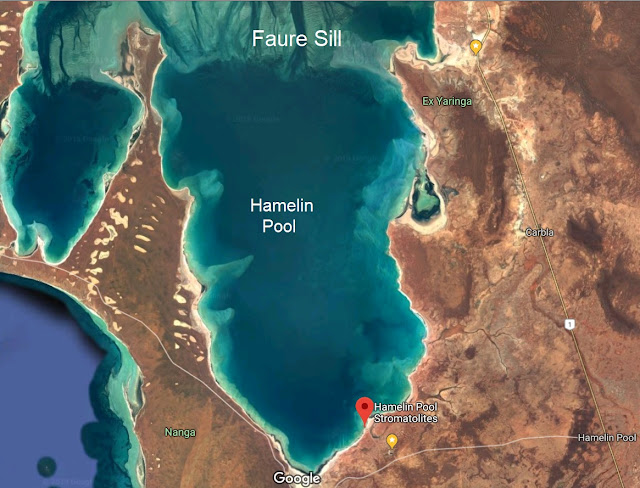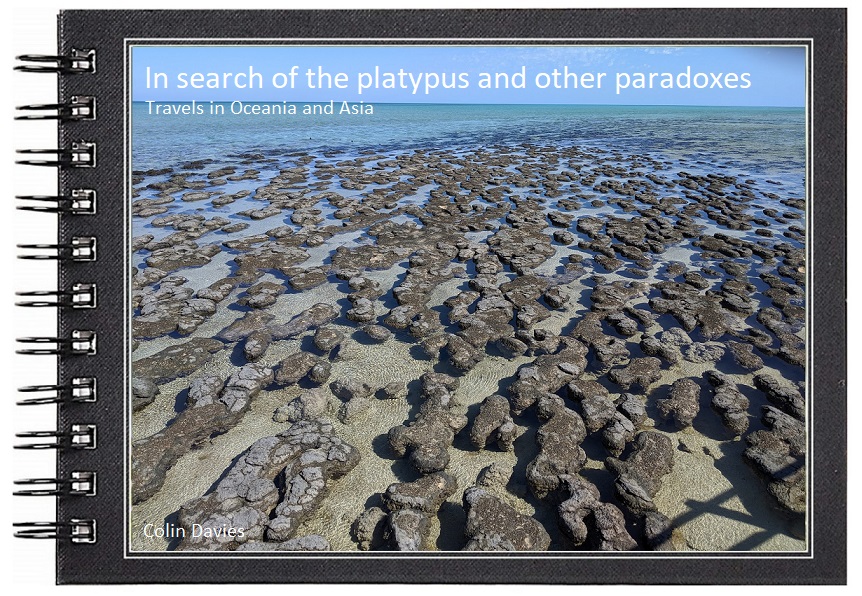Evidence of some of the earliest life on earth is found in rocks which date back 3.7 billion years and contain the fossilised remains of structures known as stromatolites. Remarkably in a very few places in the world living stromatolites still exist and the largest and most diverse selection of all are in Western Australia at Hamelin Pool.
In reality a stromatolite is not a single organism, it is in fact a structure which is created by a multitude of living organisms, especially cyanobacteria. These microscopic organisms along with others, form biofilms (microbial mats) which trap, bind and cement sedimentary grains creating layers on which more biofilms can grow. These in turn trap more sedimentary grains, creating more layers, and so it goes on, layer upon layer, so that over time the stromatolite structures form. They are as close as it gets to living rocks.
Perhaps stromatolites greatest claim to fame is the part they played in putting oxygen into the earth's atmosphere 3.7 billion years ago. When they first appeared there was virtually no oxygen in the atmosphere, but because they are photosynthetic they take carbon dioxide and water to produce carbohydrates, and in doing this they liberate oxygen. Largely thanks to this, the levels of oxygen in the earth's atmosphere rose high enough to allow other life on earth to exist. The bad news for the stromatolites was that some of this new life then consumed the cyanobacteria, thus reducing the numbers of stromatolites.
They can exist in the modern world only in extreme conditions. High levels of salinity combined with the tidal nature of Hamelin Pool and extreme temperatures often exceeding 45 degrees celcius in summer creates an environment so harsh that virtually no other plants or animals can survive, thus allowing the stromatolites at Hamelin Pool to grow undisturbed.
 |
| Photo: Map showing position of Faure Sill. Hamelin Pool is about 50km x 33km. |
The sand bar known as Faure Sill allows sea water into the bay at high tide but traps the water at low tide in the form of a shallow lagoon. High rates of evaporation in the blistering heat deposits large amounts of salt into the lagoon. At the next high tide the water floods in again and the process is repeated, day after day, year after year. This makes the water at Hamelin Pool hypersaline, around twice as saline as the ocean and virtually nothing except the cyanobacteria can live here.
It's a bizarre thing to see, living organisms which look like rocks. "It's life Jim, but not as we know it" springs to mind, and in fact I'm sure there was an episode of Star Trek in which Bones repaired a living stone which was injured. But this isn't science fiction, it's reality and what a privilege and honour to be in the presence of these very rare and ancient life forms and what a wonderful place to visit for anybody interested in the natural world. I would love to live closer to this place and learn more about what is going on here. There is a board walk and a series of information boards to help you understand and get the most out of your visit. Rather than repeat word for word what they say I have included photos of them at the bottom of this post.
It's said that when the tide covers them you can sometimes see tiny air bubbles arising.
More stromatolites.
Who needs Google Maps? This is a photo I took from my plane as we flew over Hamelin Pool on my flight from Singapore to Perth. I didn't realise that it was Hamelin Pool at the time, but you can clearly see many of the geographical features including Faure Sill.
If you take the walk from the car park it will take you through Hamelin Pool camp ground, which is well worth a visit not least because it has a tea room.
I saw several interesting bird species here, three of which were new for me, rufous songlark, chiming wedgebill and chestnut-rumped thornbill, plus a couple of budgerigars.
I'm fairly sure that this is a western netted dragon.
Rufous songlark.
Chiming wedgebills.
Signs from the boardwalk
It's a bizarre thing to see, living organisms which look like rocks. "It's life Jim, but not as we know it" springs to mind, and in fact I'm sure there was an episode of Star Trek in which Bones repaired a living stone which was injured. But this isn't science fiction, it's reality and what a privilege and honour to be in the presence of these very rare and ancient life forms and what a wonderful place to visit for anybody interested in the natural world. I would love to live closer to this place and learn more about what is going on here. There is a board walk and a series of information boards to help you understand and get the most out of your visit. Rather than repeat word for word what they say I have included photos of them at the bottom of this post.
It's said that when the tide covers them you can sometimes see tiny air bubbles arising.
More stromatolites.
Who needs Google Maps? This is a photo I took from my plane as we flew over Hamelin Pool on my flight from Singapore to Perth. I didn't realise that it was Hamelin Pool at the time, but you can clearly see many of the geographical features including Faure Sill.
If you take the walk from the car park it will take you through Hamelin Pool camp ground, which is well worth a visit not least because it has a tea room.
I saw several interesting bird species here, three of which were new for me, rufous songlark, chiming wedgebill and chestnut-rumped thornbill, plus a couple of budgerigars.
I'm fairly sure that this is a western netted dragon.
Rufous songlark.
Chiming wedgebills.
Signs from the boardwalk























No comments:
Post a Comment